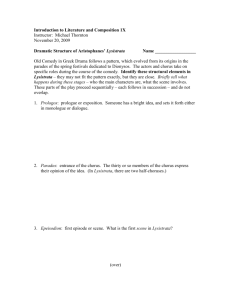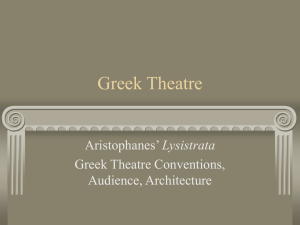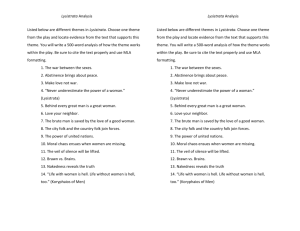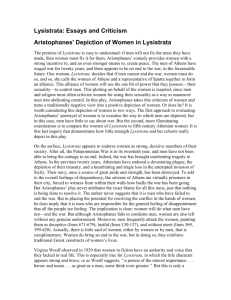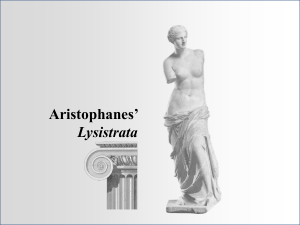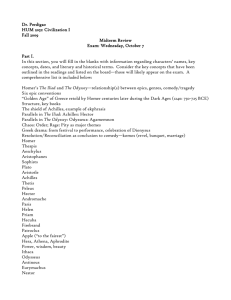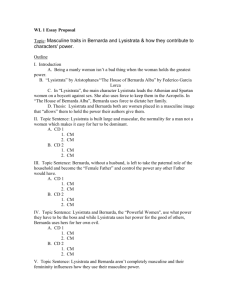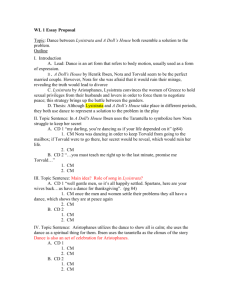Lysistrata
advertisement
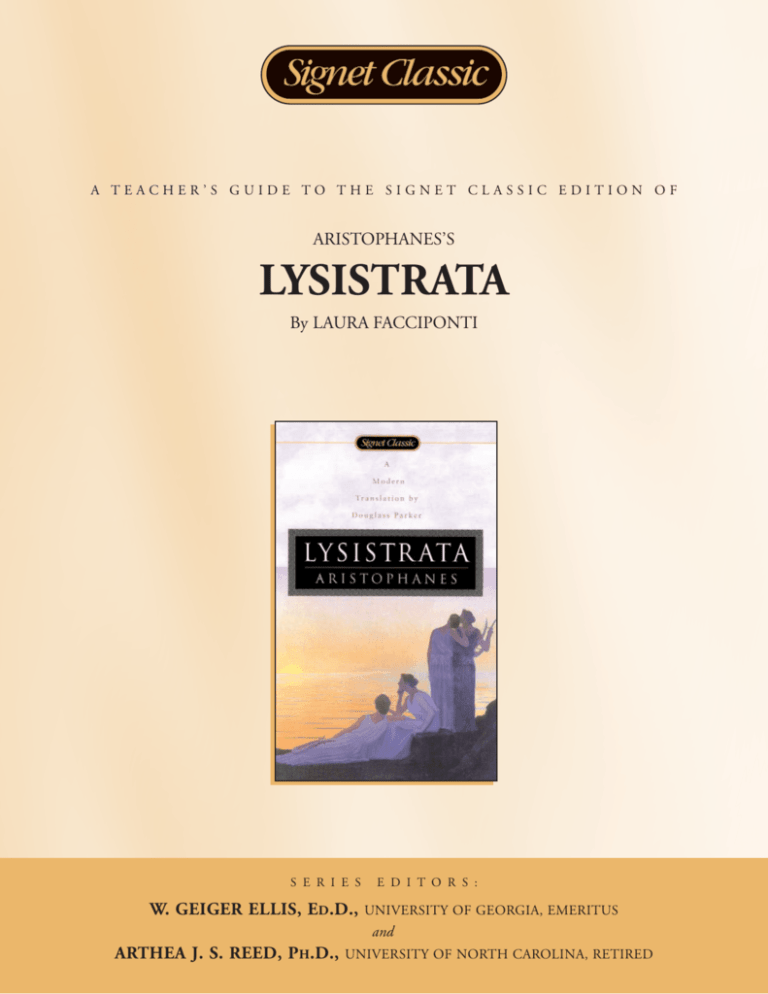
A TEACHER’S GUIDE TO THE SIGNET CLASSIC EDITION OF ARISTOPHANES’S LYSISTRATA By LAURA FACCIPONTI S E R I E S W. GEIGER ELLIS, ED.D., E D I T O R S : UNIVERSITY OF GEORGIA, EMERITUS and ARTHEA J. S. REED, PH.D., UNIVERSITY OF NORTH CAROLINA, RETIRED A Teacher’s Guide to the Signet Classic Edition of Aristophanes’s Lysistrata 2 INTRODUCTION ADULT THEMES Classic Greek comedies are frequently bawdy, using physical humor, puns, and sexually explicit language. Lysistrata, due to its subject matter, is one of the most sexually focused comedies of its time. Therefore, educators should be aware that the play and this study guide contain adult themes and language. The play refers to various men exposing erections (traditionally men wore leather phalluses for this effect), and the dialogue exchanged between characters has numerous puns on the men’s physical condition. The play also contains scenes with nudity, sexual interactions, and seduction. Although the play has significant historic and literary value, it should be taught only to mature high school, junior college, and college/university students. High school teachers should follow all the steps prescribed by their school for approval of controversial subjects. Students and parents, when appropriate, should be aware of the sexually explicit nature of the play prior to reading or viewing. Alternative selections should be available. PLOT SYNOPSIS Simply stated, the plot of Lysistrata depicts Athenian women who are fed up with the Peloponnesian War, so they barricade themselves in the Akropolis. They orchestrate a sex strike in order to force their husbands to vote for peace with Sparta. The play’s action occurs on a street in Athens in front of a gate to the Akropolis, which looms in the background. As the play begins, Lysistrata, an Athenian woman, is pacing back and forth, waiting for the women of various Greek states to gather to form an alliance for peace. Finally Kleonike, another Athenian woman, arrives. The frustrated Lysistrata complains of the women’s tardiness. Eventually more women arrive including Lampito, a strapping Spartan woman; Ismenia, a pretty Boiotian girl; and a very large Korinthian woman. After greeting each other and inspecting each other’s differences, Lysistrata asks all the women if they would prefer their husbands and sons home rather than out fighting a war. She suggests a plan of sexual abstinence as a method of peaceful coercion. The women at first refuse, but Lysistrata convinces them and leads them in an oath of allegiance. As soon as the oath is completed, loud cries are heard in the distance, and Lysistrata reveals that a group of older women, under her orders, have taken over the Akropolis. Lysistrata sends Lampito to Sparta to spread the word of their feminine alliance. The rest of the women enter into the Akropolis to set up their command center. A chorus of old men enter carrying wooden logs, torches, and fire pots. The men move slowly and are weak from age, but they plan to storm the Akropolis and punish the women who plotted against them. A chorus of old women carrying pitchers of water then enters. They confront the old men and a verbal battle ensues, ending with the chorus of women dumping their pitchers of water over the men’s heads. The Commissioner of Public Safety enters and orders his policemen to force open the Akropolis’s gates (p. 45). Once opened, Lysistrata is revealed accusing all men of having brawn and no brains when it comes to solving conflicts. The Commissioner orders the policemen to arrest her. One by one each policeman is dissuaded as the other women in the Akropolis come forward and threaten the men with various domestic weapons. Eventually a large battle ensues, and Lysistrata calls on an army of women who defeat the men using their household weapons. Beaten and disgruntled, the Commissioner requests that Lysistrata state her terms. She reveals a plan where the women will control the state budget and save the men from the war. The Commissioner angrily ridicules Lysistrata as she attempts to explain her plan. Lysistrata, aided by the other women, silences the Commissioner by wrapping him in her veil, transforming him into a figurative woman. The chorus of women dance and sing of their plans for peace. Lysistrata reveals a step-by-step approach to align the states of Greece and stop the war. The Commissioner tells the women they neither have rights nor any voice in decisions about the war. The women attack him and then retreat into the Akropolis leaving the male chorus to address the audience. The male chorus leader commands the men to ready for war and then attacks his female counterpart. The choruses strip off their tunics and engage in a naked battle of the sexes. Lysistrata enters, interrupts the battle, and announces that many of the women in the Akropolis are trying to escape. She stops a number of women in their departure who use weak excuses of domestic duty rather than admitting they simply want to return to their husbands for sex. Lysistrata convinces the women to return to the Akropolis by espousing a prophecy that describes their victory if they remain chaste. A Teacher’s Guide to the Signet Classic Edition of Aristophanes’s Lysistrata 3 The male chorus tells a story of a mighty hunter known for his celibacy and misogynous behavior. Both choruses exchange insults and fight for a second time. They are interrupted by Lysistrata who spies a man approaching the Akropolis. Myrrhine, a young Athenian woman, recognizes the man as her husband Kinesias. Lysistrata tells Myrrhine to use her womanly wiles to seduce and coerce him, but warns her to know when to stop. Kinesias arrives bearing a full erection, and Lysistrata teases him relentlessly. Kinesias, in obvious physical distress, tries many tactics to convince Myrrhine to come home and have sex with him. Myrrhine appears to succumb, suggesting that they have sex immediately. Kinesias eagerly agrees. Myrrhine offers bed, mattress, and pillow, running back and forth between Kinesias and the Akropolis. She provides all that is necessary without an ounce of sexual contact. This teasing game escalates Kinesias’s frustrated desire, so that when they are finally lying together and Myrrhine asks for his vote for peace, Kinesias cries out, “I’ll think it over!” Myrrhine runs off without satisfying him, and Kinesias delivers a tragic soliloquy, accompanied by the male chorus. A Spartan herald, wearing a cloak in an attempt to conceal his erection, is intercepted by the Commissioner who also displays an erection (p.91). The frustrated men exit, agreeing to convince their separate senates of an armistice. The male chorus chastises the female chorus, but the female chorus returns their verbal attacks with kind offers and a gentle kiss to the male chorus leader who proclaims, “Life with women is hell. Life without women is hell, too.” The two choruses unite and address the audience with an invitation to a conjoined feast of peace. Two groups of men enter, one from Athens and one from Sparta, all concealing erections underneath cloaks. They plead for peace at any cost and call upon Lysistrata to help them resolve the conflict. Lysistrata appears with Peace, a naked handmaiden, whom she instructs to lead the two groups of men to her so that she may address them. Peace does so, causing further arousal. Lysistrata points out to each party how the other had come to their neighbor’s aid in past wars and chastises them for treating each other so badly. The men guiltily agree and attempt to plan a treaty using Peace’s naked body like a map, making claims to certain parts. Lysistrata stops them and urges them to leave and purify themselves so that they may return and enter the Akropolis for a peace ceremony. She promises a home-cooked feast, concluding with the men taking their wives home. The men eagerly exit to prepare for the feast while the united choruses address the audience about their new-found appreciation for their neighbors. The drunk and happy men come out of the Akropolis, led by a flutist, celebrating their new peaceful behavior. Lysistrata matches the women with each of their men and charges all to dance and sing to the gods in thanks for this happy ending. They all do so, and exit singing and dancing. ARISTOTELIAN THEORY Aristotle writes of the poets of his time in his famous work The Poetics. He sets forth the principles of quality poetry in order of importance: plot, character, thought (theme), language, song, and spectacle. The Plot, then, is the first principle, and, as it were, the soul of a tragedy; Character holds the second place. A similar fact is seen in painting. The most beautiful colors, laid on confusedly, will not give as much pleasure as the chalk outline of a portrait.—Third in order is Thought—that is, the faculty of saying what is possible and pertinent in given circumstances. — Fourth among the elements enumerated comes Diction; by which I mean, as has been already said, the expression of the meaning in words; and its essence is the same both in verse and prose. Of the remaining elements Song holds the chief place among the embellishments. The Spectacle has, indeed, an emotional attraction of its own, but, of all the parts, it is the least artistic, and connected least with the art of poetry. (Aristotle) Classical Greek plays originated from dithyrambic poetry, which are short poems written in an inspired, wild, and irregular strain. The early playwrights eventually developed the dialogue format later recognized as dramatic literature, but the poetic nature of the writing remained inherent. Therefore, classic plays of this time are often analyzed using Aristotelian Theory. This study guide is organized by Aristotle’s six principles. Each section includes terms, discussion questions, and activities. A Teacher’s Guide to the Signet Classic Edition of Aristophanes’s Lysistrata 4 I. PLOT THE PLAY’S CLASSIC STRUCTURE Classic Greek plays follow a strict formula. The stage represents a single locale. The plot recounts the events of a single day, and the actions follow one storyline with no subplots. Aristotle described this dramatic structure in his important work On the Art of Poetry (350 B.C.). This literary formula was so revered by succeeding generations of dramatists that Aristotle’s dramatic structure was eventually adopted as the rules of playwrighting and became known as the three unities: unity of place, time, and action. Place. The setting of the play should be one location, usually on the street in front of an architectural structure. Time. The action of the play should represent the passage of no more than twenty-four hours. Previous events leading to the action are recounted on stage as exposition. Action. No action or scene in the play is a digression. All actions in the play must contribute directly to the single plotline. Lysistrata follows all these rules with the action of the entire story taking place in one day on the street in front of the Akropolis. No subplots are introduced into the simple plot. Many plays written prior to the twentieth century employ Aristotle’s unities. For example, plays written by Anton Chekhov, Henrik Ibsen, and George Bernard Shaw. Other playwrights writing before 1900 stretched the rule of place by having the action take place in locations that could be reached in one day. Or scenes took place in homes, streets, and shops of the same town, while still following the unities of time and action. Restoration playwrights William Congreve and Aphra Behn followed this modified formula. Others stretched and broke the rules. Shakespeare, for example, not only stretched the place rule but also introduced the use of subplots and mixed comedy with tragedy creating some of the first tragi-comedies. DISCUSSION FOR PLOT: 1. Test the three unities against the play Lysistrata. Did Aristophanes follow these rules? 2. How many other plays can you recall that follow the unities of time, place, and action? Read another play that follows the three unities and compare the plays by discussing these common principles. 3. What is the story of Lysistrata? Write a synopsis of the play in three sentences or in one short paragraph. Could you do this if the play did not follow the three unities? Try to write such a plot summary for a play or story that is more complicated and has one or more subplots. 4. Contemporary movies tend to be episodic and rarely follow the three unities. The intricate plots and subplots jump around in time and location. The plots and settings are more sensational. Since movies usually have extremely large budgets, reusable sets are not common. However, many classic black-and-white movies followed the unities closely. List one or more movies that follow the three unities. Write a three-line plot summary for each. 5. How realistic is the plot of Lysistrata? Would Lysistrata’s strategy for ending the war work today or in recent wars? Discuss the 1960s-70s slogan, from the Viet Nam era, “Make love not war.” ACTIVITIES FOR PLOT: 1. List the events of the play, like a police report, on a chart with a column for time of day, location, and title of the action so that you can see the progression of events and how they fall within the three unities. 2. Research the locations mentioned in the script on a map of ancient Greece and its surrounding lands so you can see distances to Athens. How long would it take Spartans to travel to Athens? 3. Write a journal of events for an entire 24 hours. Extract events from the list that could follow a singular plot, possibly in one location. Write a synopsis of these events as a play or story that follows the three unities. A Teacher’s Guide to the Signet Classic Edition of Aristophanes’s Lysistrata 5 4. Compare television shows that use the three unities and those that do not. How does each structure affect the audience’s perceptions, empathy, intrigue, and enjoyment of the story? 5. Many television sitcoms tend to follow the unity of place for purposes of budget, building only one set or a series of local set locations that the characters visit regularly. Seinfeld, Friends, and Frasier are good examples. Many popular police/detective shows follow the unity of time by posting the time of day as a caption to each scene so you can follow the story from crime to final arrest, with many events taking place within 24 hours. Watch a sitcom or a detective show and write a three-sentence play synopsis focusing on the three unites. Or, using a contemporary sitcom or detective drama as a model, write your own script following Aristotle’s unities. II. CHARACTER When Aristotle talks of character in plays, he stresses that tragedies use characters of a “higher type,” usually kings, queens, and noblemen, so that we may learn from those whom we hold in high esteem and experience great pity at their downfall. By the end of a tragedy, tragic characters fall from a great height. Comedies use characters of a “lower type,” usually common folk who have a sense of rawness or ugliness so that we can laugh at them, but not experience guilt, pity or fear from their pain. This lower characterization is aided by the use of masks. “Comedy is, … an imitation of characters of a lower type—Not, however, in the full sense of the word bad, the ludicrous being merely a subdivision of the ugly. It consists in some defect or ugliness, which is not painful or destructive. To take an obvious example, the comic mask is ugly and distorted, but does not imply pain.” (Aristotle) THE COMMON CHARACTERS Most of the characters in Lysistrata are common folk of Athens and Sparta, the highest ranking character being the Commissioner of Public Safety. The play’s title character and heroine is a common woman of Athens, Lysistrata, which means “releaser of war.” This type of protagonist is common among Aristophanes’ plays where an “outsider” and common citizen rises to the occasion and indicates his or her function as hero. Lysistrata’s allies are other common women of Athens and Sparta, with the Spartan women and men being depicted as even more common than the others through the use of slang. The men who appear to provoke the women into submission are also common soldiers and Athenians. The Commissioner, although attempting to bring order and authority to the scene, is quickly beaten down by the women and appears comic in his futile attempts at authority. THE PLAYERS OF CLASSIC GREEK COMEDY It is important to consider who the players were in classic Greek comedies. Here are a few facts about the performers of such plays: Classic Greek plays were all performed by men in masks. Men played all the parts, including the women’s parts. Therefore, one cannot help but see the irony in watching men play all these female characters who are chastising and beating them, making endless sexual comments, and spouting oaths of abstinence. Greek tragedy and comedy originated with a chorus delivering a story. A traditional chorus consisted of approximately 12 to 15 choreuts (dancers), who were young men. The size of the chorus varied slightly, but Aristophanes was unique in his use of two choruses; one chorus was far more common. At first classic Greek plays were performed only by a chorus. The individual actor, known as hypokrites, or “answerer,” was added to answer the calls of the chorus. The first actor’s name was said to be Thespis, whose name became the root of the term “thespian.” Later the single actor was called protagonistes, meaning “first competitor.” Protagonistes later developed into the main character or “protagonist.” The early Greek playwright Aeschylus introduced the second actor, deuteragonistes, and Sophocles introduced the third actor, tritagonistes. By the fifth century B.C. there were three actors and a chorus in Athenian tragedy. By the time Aristophanes was writing in 350 B.C. many more actors as well as the double chorus had been added. Each actor played several different parts within the play. The chorus members rarely left the stage, and therefore choral actors were specifically trained for dancing and singing and usually only played in the chorus. A Teacher’s Guide to the Signet Classic Edition of Aristophanes’s Lysistrata 6 The plays were often performed in theaters that held thousands of spectators, therefore the actors wore full masks of wood or leather to help accentuate their features. The masks had large gaping mouths carved out to aid in vocal amplification. The acting style was broad and highly physical so that all could see and hear each gesture. The typical classic Greek comic actor wore loose body stockings padded at the breast, buttocks, and stomach, with long floppy phalluses made of leather for the male characters. Lysistrata made an exception to this last adornment, making the phalluses erect. DISCUSSION FOR CHARACTER: 1. How does the audience view the character of Lysistrata? What figure(s) in mythology or tragedy does she most resemble? Would an ancient Greek audience respond to her differently than today’s audiences? 2. How are the “foreigners” depicted in this play? Discuss how Lysistrata and the Athenian women respond to their initial observations of the women from other lands as they arrive at the top of the play. Discuss differences in language, dialect, and slang. 3. Why do you think Aristophanes chose to have two choruses? Why older men and women? How does this choice add to the comedy? 4. Imagine the characters in mask. What expressions might each character have to represent their character and help differentiate themselves from other characters? 5. How are the male characters depicted differently than the female characters in language, actions, and physical appearance? 6. In a play filled with common characters, which character appears to hold the highest social standing? Why? How is this character treated by others? 7. How would modern audiences respond if Lysistrata were performed only by men? 8. How would modern audiences respond to the phalluses and nudity? ACTIVITIES FOR CHARACTER: 1. Research Greek gods and their appearance. Apply these images to mask designs for some of the characters in Lysistrata. Draw mask designs or actually make masks based on these designs. 2. Wear masks and attempt to act one or two of the scenes in the play. Discuss what it was like to act with a mask. Work on projecting your voice beyond the mask and using exaggerated movements with your body and full gestures so that they can be seen from a distance. 3. Choral readings can be very challenging to keep together. It is difficult to remain in unison, deliver dramatically, and be understood. Explore the challenges of performing in a Greek chorus by chorally reading with 6 to 8 students the choral odes from the text. First simply reading together, then add group movements and dramatic expressions, all in unison. 4. In a group of all boys or all girls, play characters from both genders. How does each cast provide comedy and gender perceptions by playing all the parts. III. THOUGHT/THEME Classic Greek comedy was the political satire of its age. With this in mind, looking at the thought or theme behind the comedy gives modern audiences insight into political issues in ancient Greece. What might the themes below tell us about their politics? 1. The war between the sexes. 2. Abstinence brings about peace. 3. Make love not war. 4. “Never underestimate the power of a woman.” (Lysistrata) A Teacher’s Guide to the Signet Classic Edition of Aristophanes’s Lysistrata 5. Behind every great man is a great woman. 6. Love your neighbor. 7. The brute man is saved by the love of a good woman. 8. The city folk and the country folk join forces. 9. The power of united nations. 7 10. Moral chaos ensues when women are missing. 11. The veil of silence will be lifted. 12. Brawn vs. Brains. 13. Nakedness reveals the truth 14. “Life with women is hell. Life without women is hell, too.” (Koryphaios of Men) DISCUSSION FOR THEME 1. How do you determine the theme of a piece of literature? Look at a scene in the play and identify clues from the text that lead you to the theme or thought. 2. Look at other pieces of literature, specifically poetry, and explore methods of identifying theme. 3. Why is it possible to identify multiple themes in a single text? 4. Determine a theme from an action or event, rather than from a reading. Try some of the following: a news clip from the evening news or a video-taped scene from a play, movie or TV show. How do you recognize the theme for an action? How does this differ from identifying theme in a work of literature? What new elements that were not present when reading the text contribute to the perception of theme? Consider setting, action, voice, gesture, narrative, audience perspective, individual perceptions, mood, and time of day. 5. How universal is (are) the play’s theme(s)? Discuss some of the themes. Do these apply today? How do you feel about these issues in your life? Would you be willing to take desperate measures to speak up against, change, or fight for these themes? ACTIVITIES FOR THEME 1. Write about one of the themes in your journal. How does the theme relate to contemporary issues and life? What is your personal response to the theme? 2. Since titles often reflect theme, suggest a new title for the play that best reflects its theme. 3. Write a newspaper headline that depicts the theme of the play. Write a news or feature article about the events or people in the play. 4. Write daily journal entries as you read the play. Relate your entries to a single theme. 5. Although theme is often assigned to an entire play or story, individual scenes in a play can also be assigned themes. Lysistrata is not broken into scenes, but one can easily assign scene beginnings and endings with the entrance or exit of a character. For example, the first scene ends when Lysistrata is no longer alone; a new scene begins with Kleonike’s entrance. This method of scene identification is called a French Scene, since it was identified with the French method of play writing predominant in the 1600-1700’s. Break the remainder of the play into scenes and identify a theme for each. A Teacher’s Guide to the Signet Classic Edition of Aristophanes’s Lysistrata 8 I V. L A N G U A G E POETRY AS GUIDE TO PACE Since early Greek dramas are rooted in poetry, the language or diction of the play is extremely important. Readers should pay close attention to the structure of the lines in the text, which not only suggest accents on stressed words, but also tempo of performance. An example (p. 30) of this would be: LYSISTRATA What Oath do you want? Exasperated. Something bizarre and expensive? A fancier victim—‘Take one white horse and disembowel?’ KLEONIKE White horse? The symbolism’s too obscure. LYSISTRATA Then how do we swear this oath? KLEONIKE Oh, I can tell you that, if you’ll let me, First, we put an enormous black cup right here – hollow up, of course. Next, into the cup we slaughter a jar of Thasian wine, and swear a mighty Oath that we won’t… dilute it with water. LAMPITO To Kleonike. Let me congratulate you- At first glance the line configuration may appear strange and out of alignment. Considering Lysistrata’s line “Then how do we swear this oath?” starts out in the end of the page. But if you look at it as poetry, with a continuous flow of beat pattern, Lysistrata’s line merely picks up the next beat of Kleonike’s line, “The symbolism’s too obscure.” Therefore, if three people were to read this passage, they could see where no pauses should occur between their pick-up lines, or cues, since their next line picks up the next beat. Also, you will note that a pause is suggested after Kleonike’s line, “and swear a mighty Oath that we won’t… dilute it with water” by the use of the three dots and by placing it at the end of a line. You will also notice that operative words, or stressed words, are often placed at the end of each line, so that they receive the final stress, like such words as: “enormous,” “how,” and “disembowel.” Although greater amounts of internal line stresses would have been evident in the original Greek language, by use of the iambic rhythm, it has been largely lost in the translation to English. If the scene above were placed in paragraph form, to show pace, it would read something like this: (stressed words are in bold) (LYSISTRATA) What Oath do you want? Something bizarre and expensive? A fancier victim – (pause) ‘Take one white horse and disembowel?’ (KLEONIKE) White horse? The symbolism’s too obscure. (LYSISTRATA) Then how do we swear this oath? (KLEONIKE) Oh, I can tell you that, if you’ll let me, First, we put an enormous black cup right here – hollow up, of course. Next, into the cup we slaughter a jar of Thasian wine, and swear a mighty Oath that we won’t… (pause) dilute it with water.(LAMPITO to Kleonike) Let me congratulate you- (pause) Sticomythia, short exchanges of dialogue between characters creating a rapidly paced discussion of one-liners, is often used in Greek plays as an additional method of influencing the pace and rhythm of dialogue. An example of this can be found in the exchange between Lysistrata and Kinesias on pages 77-81 and in example #2 of Metaphors and Puns below. A Teacher’s Guide to the Signet Classic Edition of Aristophanes’s Lysistrata 9 ARISTOPHANES’ USE OF METAPHORS AND PUNS The comic playwrights of ancient Greece, particularly Aristophanes, are well known for taking advantage of metaphor and puns, or play-on-words. In Lysistrata there are numerous possibilities for double meanings in words, particularly those that carry sexual innuendos. Here are some passages that contain examples of metaphor and Aristophanes’ humorous puns. 1. On pages 59-61 Lysistrata and the Commissioner use metaphors and puns to describe the state of affairs in Athens. They begin talking of the behavior of the soldiers in the market place and use common foods to represent their behavior. The Commissioner refers to Hella’s affairs as being “in one hell of a snarl.” Lysistrata extends the metaphor to describe the war. LYSISTRATA It’s rather like yarn. When a hank’s in a tangle, we lift it-so-and work out the snarls by winding it up on spindles, now this way, now that way. That’s how we wind up the war, If allowed: We’ll work out the snarls by sending Special Commissions— Back and forth, now this way, now that way—to ravel These tense international kinks. The Commissioner ridicules Lysistrata’s choice of metaphor, but Lysistrata develops the analogy further. COMMISSIONER I lost your thread, but I know there’s a hitch, Spruce up the world’s disasters with spindles—typically Woolly female logic. LYSISTRATA If you had a scrap of logic, you’d adopt Our wool as a master plan for Athens. COMMISSIONER What course of action Does the wool advise? LYSISTRATA Consider the City as fleece, recently Shorn. The first step is Cleansing: Scrub it in a public Bath, and remove all corruption, offal, and sheepdip.* (*the metaphor continues on page 61) 2. On pages 79-81 Kinesias and Lysistrata trade puns, playing on his condition and the literal and sexual double meaning of his name, “to move.” LYSISTRATA Who goes there? Who penetrates our positions? KINESIAS Me. LYSISTRATA A Man? KINESIAS Every inch. _______________ A Teacher’s Guide to the Signet Classic Edition of Aristophanes’s Lysistrata LYSISTRATA Meeting you—I’m overcome! Your name, you know, Is not without its fame among us girls. Aside. —Matter of fact, we have a name for it.I swear, you’re never out of Myrrhine’s mouth. She won’t even nibble a quince, or swallow an egg, Without reciting, “Here’s to Kinesias!” _______________ KINESIAS Bring her out here! LYSISTRATA Really? And what would I get out of this? KINESIAS You see my situation. I’ll raise whatever I can. This can all be yours. LYSISTRATA Goodness. It’s really her place. I’ll go and get her. KINESIAS Speed! —Life is a husk. She left our home, and happiness went with her. Now pain is the tenant. Oh, to enter that wifeless house, to sense that awful emptiness, to eat that tasteless, joyless food—it makes it hard, I tell you. Harder all the time. Aristophanes enjoys playing on words that illustrate the war between the sexes. LYSISTRATA Women! Utter sluts, the entire sex! Will-power, nil. We’re perfect raw material for Tragedy, the stuff of heroic lays. “Go to bed with a god and then get rid of the baby” – that sums us up! (page 26) _______________ 10 A Teacher’s Guide to the Signet Classic Edition of Aristophanes’s Lysistrata KORYPHAIOS OF MEN I’m never surprised, At my age, life is just one damned thing after another. And yet, I never thought my wife was anything more than a home-grown bother, But now, dadblast her, she’s a National Disaster! (page 36) _______________ KORYPHAIOS OF MEN Queen Athene, let these strumpets crumple before our attack. Grant us victory, male supremacy… and a testimonial plaque. (page 40) _______________ FIRST SEMICHORUS OF WOMEN Speed! Celerity! Save our sorority from arson. Combustion. And heat exhaustion. Don’t let our sisterhood shrivel to blisterhood. Fanned into slag by hoary typhoons. By flatulent, nasty, gusty baboons. (page 41) _______________ KORYPHAIOS OF MEN Oops. Female troops. This could be upsetting. I didn’t expect such a flood of reserves. KORYPHAIOS OF WOMEN Merely a spearhead. If our numbers stun you, watch that yellow streak spread. We represent just one percent of one percent of This Woman’s Army. (page 42) _______________ COMMISSIONER Useless. Your suit won’t hold water. Right’s on their side. For female depravity, gentlemen, WE stand guilty— we, their teachers, preceptors of prurience, accomplices before the fact of fornication. We sowed them in sexual license, and now we reap rebellion. The proof? Consider. Off we trip to the goldsmith’s to leave and order: “That bangle you fashioned last spring for my wife is sprung. She was thrashing around last night, and the prong popped out of the bracket. I’ll be tied up all day—I’m boarding the ferry right now—but my wife’ll be home. 11 A Teacher’s Guide to the Signet Classic Edition of Aristophanes’s Lysistrata 12 If you get the time, please stop by the house in a bit and see if you can’t do something—anything—to fit a new prong into the bracket of her bangle.” And bang. Another one ups to a cobbler—young, but no apprentice, full kit of tools, ready to give his awl— and delivers this gem: (pages 46-47) _______________ LYSISTRATA Of course. What did you expect? We’re not slaves; we’re freeborn Women, and when we’re scorned, we’re full of fury. Never Underestimate the Power of a Woman. (page 51) _______________ COMMISSIONER I categorically decline to shush for some confounded woman, who wears—as a constant reminder of congenital inferiority, an injunction to public silence—a veil! Death before such dishonor! LYSISTRATA Removing her veil If that’s the only obstacle… I feel you need a new panache, so take the veil, my dear Commissioner, and drape it thus— and SHUSH! As she winds the veil around the startled Commissioner’s head, Kleonike and Myrrhine, with carding-comb and wool-basket, rush forward and assist in transforming him into a woman. (page 57) DISCUSSION FOR LANGUAGE 1. How are analogies and metaphors used throughout the play to further plot, character, and theme? Copy your favorite analogies and metaphors in your journal and write a paragraph about how they develop and move the play. 2. How many puns can be found on one word or image? Locate puns on words and images used in the play. Record some in your journal. 3. Try your hand at developing your own puns. 4. Identify analogies in advertisements, magazine or newspaper articles, sportscast- ing, and movies and television shows. Record them in your journals. 5. How is language used to portray differences in character, intelligence, place of origin, rank, and gender? List examples from the play in your journal. 6. How does the rhythm of the language differ between the choral odes and the dialogue in the play? Find scenes where stichomythia, short one-liners exchanged between characters, is used to enhance the rhythmic exchange of dialogue? A Teacher’s Guide to the Signet Classic Edition of Aristophanes’s Lysistrata 13 ACTIVITIES FOR LANGUAGE 1. In journal entries, describe the events of a day or a situation using metaphors. 2. Divide into groups. Select a word or subject that can have many meanings. List puns and/or common sayings related to that word. Share them with the class. 3. Pick a scene from Lysistrata, paying attention to the rhythm of the lines, pauses, and phrasing, and read the scene aloud to the class. 4. On page 92 the Commissioner and the Herald make a joke about a Spartan epis- tle. In the notes on page 121, the Spartan epistle is described as “a tapered rod which was Sparta’s contribution to cryptography. A strip of leather was wound about the rod, inscribed with the desired message, and unwound for transmis- sion. A messenger then delivered the strip to the qualified recipient, who deci- phered it by winding it around a rod uniform in size and shape with the first. Any interceptor found a meaningless string of letters.” Make your own Spartan epistle and share it with other students, the class or other classes. Provide directions on how to put the code together again. 5. Use a sporting event as an analogy for something else. Now extend that analogy into a metaphor. 6. Illustrate (drawing, painting, collage) an analogy or metaphor from the play or one of your own. 7. Compose a short scene with a contemporary “battle of the sexes.” Try your hand at incorporating puns, analogies, and metaphors. 8. Make a map of your school campus. Use puns to describe locations on the map. V. M U S I C Greek plays originated out of poetic song and dance. Therefore, musicality is innate in the Greek playwrighting tradition. The most obvious use of music is found in the choral odes, originally sung and danced by performers specifically trained to perform them. Musical language also can be found within the dialogue since the plays were originally written in iambic meter. However, much of this rhythm has been lost in translation. TERMS FOR MUSIC: Anapaests: a meter that can be chanted or sung, like a march, metrical scheme, u u — | u u — || u u — | u u — (u = short stroke, — = long stroke). Auletes: a musician (without mask) who played the aulos and came on with the chorus to accompany their songs. Aulos: a type of double flute or oboe-like instrument used to accompany lyric passages. Dochmiacs: a meter often found in tragedies expressing passages of distress, metrical scheme, u — — u — and — u u — u —. Exodos: the section of the play following the last stasimon, or choral ode, also considered the “finale”. Iambic trimeter: the spoken meter of Greek drama, basic metrical scheme, u — u — | u — u — | u — u —. Kommos: sung or chanted exchange between actor(s) and chorus, often highly emotional. Metrical schemes: notation used to describe meters. u = a short syllable; — = a long syllable; | = notation used to mark off individual metra || = dieresis. Metron: metrical unit used to compose a particular type of verse. Monody: lyric sung by single actor or solo. Parodos: a song sung by chorus as it first enters the orchestra. Stasimon: lyric ode sung with accompanying dance by the chorus, usually with no actors present. Triadic structure: typical metrical division of choral stasima featuring pairs of ‘stanzas’ that are metrically identical to one another (the strophe and antistrophe), each pair is often followed by a “refrain” (the epode) composed with a different metrical pattern. Trochaic tetrameter: a chanted meter and often associated with agitated scenes, basic metrical scheme, — u — — | — u — — || — u — — | — u —. (Brown, A., A New Companion to Greek Tragedy) A Teacher’s Guide to the Signet Classic Edition of Aristophanes’s Lysistrata 14 DISCUSSION FOR MUSIC 1. Imagine the choral odes sung by the men’s and women’s choruses. How might singing and dancing these odes add to the comedy of the play? 2. Why do you suppose Aristotle placed music so low on the priorities of dramatic elements when so much of the play is based in music, dance, and internal rhythm? 3. Imagine men dancing and singing both the men’s and women’s chorus parts. How did music, dance, and voice of these performers differentiate the genders? ACTIVITIES FOR MUSIC 1. Select a choral ode from the play. Reword it so that it rhymes and fits within a defined meter. Explore the musical qualities of the passage. Recite the passage to a metronome or drum beat and develop a rap or sing the ode to a popular tune that matches its rhythmic pattern. 2. Explore Greek music and imagine some of the melodic lines used in the choral odes. Use these tunes for the exercise above. 3. Research Greek traditional dances and discuss what types of dances might be used in choral odes. How might these dances be distorted or satirized to support the comic effect of the men’s and women’s chorus? Try to perform one or more of these dances for the class. 4. Write the entire story of Lysistrata as a rap song. Perform your rap song for the class. 5. Find examples of the musical terms in the play. List in your journal the term and next to it the example. Or, do this activity in a small group using chart paper. V I . S P E C TA C L E Spectacle includes all the visual aspects of a production: the stage, set, props, costumes, lights, sound effects, and special effects. Traditional Greek theater used spectacle sparingly. However, they did have some machines for special effects, carts to carry on and off certain characters, and detailed masks and costumes. THE GREEK THEATRE Traditional Greek theater was performed outdoors during daylight hours. The theatre space, or theatron, was typically an arena with the audience in a semi-circle around the performance area. Seats extended backwards in a step formation. Since Dionysus was the honored god of theatre, often a statue of Dionysus was placed in the front row of the audience area so that he might view the performance given in his honor. A sacrificial altar was often found in the theatron or directly on the orchestra area for sacrifices to Dionysus and other honored gods during the performances. THE PERFORMANCE SPACE AND SETS The performance space was flat, and later Greek theatres had a small scene (skene) building at the rear, facing the audience. The main actors made all their entrances from the scene building. Here the actors changed costumes and masks, and most of the special effects or machines for magical entrances were housed. Ancient Greek theatre rarely added additional sets, but at times adorned the scene building with minor set dressings and accessories to help depict a specific location or required structure. Special wagons or carts were built to carry on and off characters who died or to elevate and float the gods. Various traps and machines for special effects were designed and housed in the scene building to create storms, smoke, and magical god entrances. THE CHORUS AND THE ORCHESTRA The flat circular area directly in front of the audience was usually reserved for the chorus and was called the orchestra. The chorus often made their entrances through the audience and remained in the orchestra throughout the performance. The main characters typically came down to the orchestra and interacted with the chorus, but the chorus rarely went up to the scene building. Once the chorus arrived on stage, it usually remained on stage as an interpreter of the play’s action for the audience. A Teacher’s Guide to the Signet Classic Edition of Aristophanes’s Lysistrata 15 TERMS FOR SPECTACLE: Mechane (Latin: machina): a crane used to portray figures in flight, usually gods (hence the term deus ex machina: ‘the god from the machine’). Orchestra: ‘the dancing floor’ or area in front of the skene where the chorus danced. Skene: the stage building found up stage of the orchestra (origin of our ‘scene’). Theatron: “theater” or the seeing place, and more specifically the seating-area for the audience. Theologeion: raised structure from which supernatural beings spoke, located above skene or on the skene roof. (Brown, A., A New Companion to Greek Tragedy) DISCUSSION FOR SPECTACLE 1. Keeping in mind the ancient Greek stage, how might the play be staged? Where would the main characters enter? Where would the two choruses enter and per form? How would the gate to the Akropolis be positioned, and how would the men storm the gate? 2. Considering ancient theater traditions, what special effects might be used in this play? Suggest special effects for building structures, masks, sound effects, the fire pots and logs the men’s chorus carry, the baby, the phalluses, and the passing of time. 3. The play describes various scenes where disrobing occurs. What would the char acters be wearing and how many layers might they have to disrobe? How might the Athenian women dress differently from the Spartan women? 4. The use of phalluses comically depict the men’s physical condition. How would modern audiences respond to this? Could this play be produced without the use of phalluses? How might this aspect of the play be perceived differently if women played the women’s parts? 5. Why did Aristotle place spectacle last on the priority list of important dramatic elements? ACTIVITIES FOR SPECTACLE 1. Design costumes, based on research of ancient Greek dress, for the main characters of the play and the two choruses. Consider all the pieces of clothing mentioned in the script as well as the character’s personalities and comic effect and satire when making design decisions. 2. Create a diorama of the ancient Greek theatre and add set pieces and actors to scale. Stage scenes using the figures and explore stage entrances, exits, and movement on stage. Suggest possible set designs to enhance the traditional skene building of the ancient Greek theatres. 3. Imagine Lysistrata as a modern Broadway musical and consider spectacle as if it were higher on the list of priorities. With an unlimited budget, what modern special effects would you use to enhance this play? In a small group, diagram some of your ideas? ONLINE RESOURCES http://didaskalia.berkeley.edu/stage.craft/greek.html This is a detailed website with diagrams of ancient Greek stages, history, and descriptions of staging techniques for Greek and Roman theatre. http://classics.mit.edu/index.html This website is out of MIT’s Classics department, providing full texts of 441 works of classical literature by 59 different authors, including user-driven commentary and “reader’s choice” websites. The site contains mainly Greco-Roman works (some Chinese and Persian), all in English translation. The site also assists you in searches within the texts and provides trivia questions and links for purchasing books on the subject matter. This site does not have the full text of Lysistrata, but does have a number of plays by Aristophanes and his contemporaries. http://classics.mit.edu/Aristotle/poetics.1.1.html This site has the complete text of Aristotle’s Poetics translated by S.H. Butcher. http://www.uwm.edu/Dept/Library/special/exhibits/clastext/clspg033.htm This site explores various editions of the plays of Aristophanes, including a publication of Lysistrata illustrated by Pablo Picasso. A Teacher’s Guide to the Signet Classic Edition of Aristophanes’s Lysistrata 16 http://www.perseus.tufts.edu/cgi-bin/ptext?doc=1999.04.0009 This is a Classics website at Tufts University providing countless links to sites on Greek theater including historical and biographical information and examples of Greek staging. The site focuses on Thomas R. Martin’s course, An Overview of Classical Greek History from Homer to Alexander. http://kids.infoplease.lycos.com/ce6/ent/A0857813.html This site contains historical and literary references to Greek theater from The Columbia Electronic Encyclopedia, on factmonster.com. © 2000 Learning Network. http://www.temple.edu/classics/dramadir.html This site serves Dr. Robin Mitchell-Boyask’s Greek Drama and Culture course at Temple University. This Classics course site is quite comprehensive and includes information about Greek theater and background information on a number of Greek plays, including helpful study guides including one on Lysistrata. There are also links to information about Greek mythology and culture. http://www.About.com Informative discussion articles and websites can be found in a search under “Aristophanes” or “Lysistrata” with About.com. Each page includes links to other pages and articles about the subject matter of Greek theater as well as articles on the subject matter of Lysistrata. http://www.theatrehistory.com/ancient/aristophanes001.html This site is a link from TheatreHistory.com titled, Aristophanes and His Comedies and extracts historical information in great detail from The Drama: Its History, Literature and Influence on Civilization, vol. 2. ed. Alfred Bates. London: Historical Publishing Company, 1906. pp. 7-16. BIBLIOGRAPHY Aristotle, The Poetics, Penguin Classics, translated by Malcolm Heath, New York, 1997. Brooke, Iris, Costume in Greek Classic Drama, Greenwood Press, Westport, CT, 1973. Brown, A., A New Companion to Greek Tragedy, Barnes and Noble, London, Canberra, and Totowa, NJ, 1983. Green, Richard and Handley, Eric, Images of the Greek Theatre, University of Texas Press, Austin, TX, 1995. Lonsdale, Steven, Dance and Ritual Play in Ancient Greek Religion, Johns Hopkins University Press, Baltimore and London.1993. McLeish, Kenneth, The Theatre of Aristophanes, Taplinger Publishing Company, Thames and Hudson, 1980. West, M.L., Ancient Greek Music, Oxford University Press, London, 1992. Wiles, David, The Masks of Menander, Cambridge University Press, London. 1997. B I O G R A P H Y O F L A U R A FA C C I P O N T I Laura Facciponti is an assistant professor of drama at the University of North Carolina at Asheville, where she is the head of the acting program. She teaches acting and voice and is a professional actor, stage director, playwright, and storyteller. She wrote a modern musical adaptation of Aristophanes’ The Birds, called Birds of a Feather, which was produced for the first time on the UNCA campus in the spring of 2002. She has an M.F.A. in directing and acting from Syracuse University, and a B.F.A. in the Related Arts from Kutztown University of Pennsylvania. Laura worked as a teaching artist with the Utica, NY Arts in Education Program, modeled after the Lincoln Center Arts in Education Program. She was the co-founder and artistic director of World Theatre Works, a theatrical storytelling company that performed in schools and festivals in eastern Pennsylvania, as well as provided workshops for teachers on how to incorporate storytelling into the classroom. She also founded and serves as artistic director for UNCA’s bi-annual storytelling festival, Mountain Echoes Storyfest. Other study guides written by Ms. Facciponti for Signet Classics are Shakespeare’s Antony and Cleopatra and The Mousetrap and Other Plays (co-authored). ABOUT THE EDITORS OF THIS GUIDE W. GEIGER ELLIS, Professor Emeritus, University of Georgia, received his A.B. and M.Ed. degrees from the University of North Carolina (Chapel Hill) and his Ed.D. from the University of Virginia. His teaching focused on adolescent literature, having introduced the first courses on the subject at both the University of Virginia and the University of Georgia. He developed and edited The ALAN Review. ARTHEA (CHARLIE) REED, PH.D. is currently a long-term care specialist with Northwestern Mutual Financial Network and senior partner of Long-Term Care and Associates. From 1978 to 1996 she was a professor of education and chairperson of the Education Department at the University of North Carolina at Asheville. She is the author or co-author of 15 books in the fields of adolescent literature, foundations of education, and methods of teaching. She was the editor of The ALAN Review for six years and president of the Assembly on Literature for Adolescents of the National Council of Teachers of English (ALAN). She is currently co-authoring the 5th edition of A Guide to Observation, Participation, and Reflection in the Classroom (McGraw-Hill 2004). She has taught almost every grade from second grade through doctoral candidates. She lives in Asheville, North Carolina with her husband Don, two dogs, and a cat. FREE TEACHER’S GUIDES A full list of Teacher’s Guides and Teacher’s Guides for the Signet Classic Shakespeare Series is available on Penguin’s website at: www.penguin.com/academic TEACHER’S GUIDES Animal Farm • Anthem • Beloved • Beowulf • The Call of the Wild • Cannery Row • City of God • The Country of the Pointed Firs and Other Stories • The Crucible • Death of a Salesman • Dr. Jekyll and Mr. Hyde • Dubliners • Ethan Frome • The Fountainhead • Girl in Hyacinth Blue • The Grapes of Wrath • A Journey to the Center of the Earth • The Jungle • The Life of Ivan Denisovich • Looking Backward • Lysistrata • Main Street • Of Mice and Men • The Mousetrap and Other Plays • A Narrative of the Life of Frederick Douglass, An American Slave • Nectar in a Sieve • 1984 • The Odyssey • The Passion of Artemisia • The Pearl • Persuasion • The Prince and the Pauper • A Raisin in the Sun • The Red Pony • Redwall • The Scarlet Letter • The Scarlet Pimpernel • Silas Marner • A Tale of Two Cities • The Time Machine • Up from Slavery • The Women of Brewster Place • Wuthering Heights TEACHER’S GUIDES FOR THE SIGNET CLASSIC SHAKESPEARE SERIES Antony and Cleopatra • As You Like It • Hamlet • Henry V • Julius Caesar • King Lear • Macbeth • Measure for Measure • A Midsummer Night’s Dream • Much Ado About Nothing • Othello • Richard III • Romeo and Juliet • The Taming of the Shrew • The Tempest • Twelfth Night Visit the Penguin Group (USA) web site at www.penguin.com to browse all Signet Classic paperback editions and www.penguin.com/scessay for information about the Annual Signet Classic Scholarship Essay Contest
